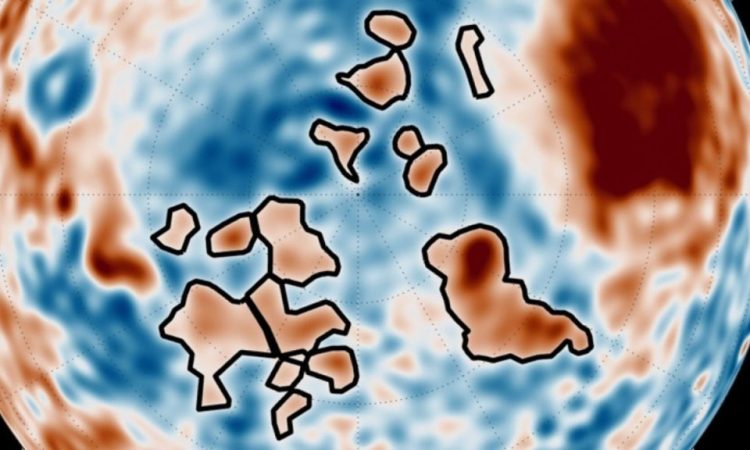
Thanks to the new gravitational map of Mars, geologists have discovered gigantic structures under what was once the Red Planet’s ocean.
A new gravity map of Mars was presented at the Europlanet Science Congress 2024, offering an unprecedented view of the structures hidden beneath the surface of the Red Planet. This map reveals the presence of dense, large-scale formations beneath a lost ancient Martian ocean and suggests that active processes may be underway in the mantle beneath Olympus Mons, the Solar System’s largest volcano.
Advertisement
The analysis, led by Bart Root of Delft University of Technology, combines data from several space missions, including NASA’s (Interior Exploration using Seismic Investigations, Geodesy and Heat Transport). The innovation lies in the ability to detect small deviations in the orbits of the probes around Mars, from which it was possible to obtain information on the global gravitational field of the planet. The results of this study will be published in the article “The global gravity field of Mars reveals an active interior” in the next edition of JGR: Planets.
Surprising discoveries at the north pole
One of the most fascinating discoveries concerns the detection of mysterious dense structures beneath the northern polar plains of Mars. , buried beneath a smooth layer of sediment thought to be the remains of an ancient seabed, are approximately 300-400 kg/m³ denser than their surroundings. Although not visible on the surface, these structures suggest a complex and unknown geological history.
Giant impact basins on the Moon, for example, show similar anomalies due to the greater density of impactors. However, anomalies in the northern hemisphere of Mars show no obvious evidence of surface impacts. According to Dr. Root, these dense structures could result from ancient volcanic activity or from the compaction of material following ancient impacts. “We identified about 20 features scattered around the area surrounding the north polar ice cap, one of which has a shape that resembles a dog,” Root explained.
An isostasy that defies expectations
The theory of flexural isostasy, which describes how a planet’s crust responds to external loads, appears to behave anomalously on Mars. On Earth, for example, it rises as the ice melts, offsetting the weight that once pushed it down. However, on Mars, the volcanic area called Tharsis Rise, which is home to Olympus Mons and other huge volcanoes such as Arsia Mons, Pavonis Mons and Ascraeus Mons, is not behaving as expected. Instead of pushing down, Tharsis Montes rises significantly above the rest of the surface.
According to the authors of the study, this suggests that the subsurface of Mars may be more complex than previously thought. The gravitational signal detected on the surface fits a model that treats Mars as a thin shell, but it appears that active processes in the mantle are pushing the entire volcanic region upwards. “A light mass, probably a column of magma, may be pushing up from the mantle, suggesting that Mars may still have active movement within it,” the authors say.
The team hypothesized the presence of a light mass about 1750 kilometers in diameter and at a depth of 1100 kilometers, which would be lifting the Tharsis region. This process could be caused by a huge column of magma traveling towards the surface, opening up the possibility of future volcanic activity on the planet.
Towards new explorations
To better understand these structures and the gravitational behavior of Mars, it is essential to obtain new data. Root’s team is behind a mission called Martian Quantum Gravity (MaQuIs), designed to map Mars’ gravitational field at a fine level of detail. The mission would rely on technologies similar to those used in the GRAIL (Gravity Recovery and Interior Laboratory) missions on the Moon and GRACE (Gravity Recovery and Climate Experiment) on Earth.
The MaQuIs missionwhich involves the use of two satellites in tandem connected via an optical system, could provide crucial information about the subsurface of Mars, including mantle convection processes and the possibility of underground water reserves. “These observations would allow us to better explore hidden features of Mars and study atmospheric seasonal changes and other dynamic processes,” explained Dr. Lisa Wörner from DLR, who presented the MaQuIs mission at EPSC 2024.
Pending further developments, the new gravitational map of Mars opens new avenues for understanding the geological history of the planet and its potential future volcanic activities.
Read more:

